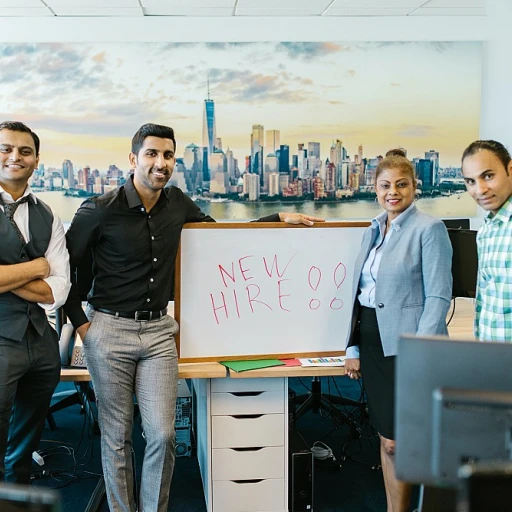Understanding the Role of Recruitment Management in HR
Decoding the Purpose of Recruitment Management in HR
In the grand scheme of human resources, recruitment management stands as one of the pivotal areas. It's the heart and soul, quite literally, as fresh talent infusion keeps organizations dynamic and agile. Roles within recruitment management focus on identifying top talent, coordinating the hiring process, and ultimately shaping and maintaining the company’s employer brand—the public perception of your organization as an employer.
Recruitment is not merely about filling vacancies anymore. It's about building a pipeline of promising candidates, streamlining the selection process, and ensuring a smooth onboarding experience. Today, with the growth of social media and applicant tracking systems, companies have unprecedented tools at their disposal, making recruitment management a finely tuned strategy rather than a once-in-a-while task.
Success in recruitment stems from understanding what your company truly needs in terms of both skill sets and cultural fit. It's about always being a few steps ahead by foreseeing future talent needs and aligning them with business objectives. The art of managing these processes is not just about sourcing talents but crafting experiences for employees, making them feel valued even before they become part of the workforce.
A solid recruitment management system (RMS) allows for tracking potential employees during the hiring process and creating a seamless experience from first contact to job offer. The evolutionary processes within recruitment management ensure that HR departments not only meet their hiring needs but also foster an environment where talent thrives.
While this introduction underscores the importance of recruitment management, other aspects, like crafting a comprehensive recruitment strategy or overcoming challenges, are also essential to explore. Understanding these elements within the broader context can transform your company’s approach to hiring. For more on handling diverse teams within HR, read about
effectively managing diverse teams in HR.
Crafting a Comprehensive Recruitment Strategy
Building a Strong Recruiting Plan
Creating a recruitment strategy is crucial not just for finding potential employees, but for attracting top talent. The first thing is to clearly define the roles of your recruitment management system (RMS) and human resources. By understanding each step in your hiring process, you'll streamline efforts and save precious time. Think of the selection process like cooking a recipe; each ingredient and step is necessary to get the right results.
One fine example of a comprehensive strategy is using job boards and social media to reach out to candidates. Engage them where they already are. What better way to find a great fit than by meeting candidates halfway? Leverage social media platforms and integrate applicant tracking systems to keep a pulse on potential candidates. A good management system ensures you keep track of resumes, applications, and communication with ease.
Adapting Technology in Your Hiring
Gone are the days of managing huge stacks of resumes manually. Incorporating technology into your recruitment process can make life easier for everyone involved. Tools like RMS provide an all-in-one solution for managers and recruiters. With an efficient management system, you can sift through applications, pick up on top candidates, and even schedule interviews, all via a few clicks.
These tools let your team focus on building rapport with potential employees instead of drowning in paperwork. Additionally, embracing modern technology in recruitment fosters a better candidate experience. They know where they stand within the process, reducing anxiety and keeping their interest high.
Optimizing Candidate Experiences
When candidates apply, they are hoping for a smooth and respectful journey. So, paying attention to the candidate experience is non-negotiable. A positive experience can transform an applicant into an advocate for your company even if they aren’t hired immediately.
Personalize communication—the human touch never gets old! Ensure timely feedback at each stage of the hiring process. Candidates appreciate transparency and swift communication. Remember, a seamless process speaks volumes about your employer brand and could place your company at the top of their list.
Creating Metrics for Success
It's important to measure recruitment success accurately. But how do you know when you've hit success? Start with aligning recruitment goals with company objectives. Effective ways to manage diversity in the workplace can also serve as a solid metric for success, enhancing your brand's reputation.
Monitor recruitment KPIs like time-to-fill, conversion rates from application to interview, and source of hire. They are like signposts guiding you toward more refined strategies. Remember, numbers tell a story, so tune in to what they say about your recruitment process management.
Understanding and implementing these steps into your recruitment strategy can set your human resource team apart, making it efficient and candidate-friendly. Engagement isn't just about filling a vacancy; it's about building a relationship that is mutually beneficial for the company and its future employees.
Utilizing Technology in Recruitment Processes
Embracing Technological Tools for Effective Hiring
In today's fast-paced world, technology has too quickly become an essential part of recruitment management. With the right tools, companies can not only speed up their hiring process but also ensure they attract the best talent. Here’s how technology can step up your recruiting game:
- Applicant Tracking Systems (ATS): These are game-changers when it comes to sorting through large volumes of resumes and applications. ATS helps in organizing candidate information, making it easier for the hiring team to focus on candidates who truly fit the job. With reports suggesting about 98% of Fortune 500 companies use an ATS, it's a tool that's hard to ignore.
- Job Boards and Social Media: Gone are the days of traditional job hunting. Platforms like LinkedIn, Indeed, and even Facebook have revolutionized the way companies and candidates interact. Companies can post job openings more broadly and attract a diverse range of applicants.
- Recruitment Management Systems (RMS): Think of RMS as the swiss army knife for recruiters. These systems centralize recruitment activities, from selection process to candidate communication, enhancing the overall management system.
- AI and Automation: Certain tools use artificial intelligence to match candidates' skills with job requirements, reducing the time and human resource effort spent on initial screening.
Incorporating these technological advances into your recruitment management strategy is crucial for more efficient and successful hiring. Companies that utilize them benefit not only by saving time but also by enhancing candidate experience, ensuring they attract top talent. As technology continues to evolve, keeping your recruitment strategy aligned with these tools can be challenging, but incredibly rewarding.
Additionally, for more insights into managing your team effectively after recruitment, you might find this resource helpful on
building strong employee relationships.
Enhancing Candidate Experience
Creating Memorable Journeys for Job Applicants
The dance between employers and job hunters is like a performance. Crafting a welcoming and smooth hiring process is the essence of drawing in top-notch talent. Let's face it, a well-organized recruitment process not only wins over the best candidates but ensures they leave with a story to tell.
Incorporating the essence of your company's culture into interactions with prospective employees is like painting a vivid picture. It's about more than just outlining job duties; it's about showcasing your unique workplace environment and values. A personal touch in recruitment selection can convert candidates into employees who are genuinely thrilled to be part of your journey.
Keeping Up with Timely Responses
One simple, yet effective trick is to keep the lines of communication open and current. We're living in an era of immediate feedback, and job applicants are no exception. They appreciate being informed at every stage of the process. It's a small courtesy that makes a big difference to someone's experience.
Applicant tracking systems and recruitment management systems can aid massively here. They serve as your trusty assistant in ensuring no prospective employee is left waiting unnecessarily. Many companies turn to technology for the added efficiency, playing a pivotal role in bridging the gap between applying and onboarding.
The Human Touch in Technology
While tracking systems take up the legwork of logistical tasks, don’t lose the warmth that only a human presence can offer. It's the people that define companies, and your hiring team should radiate the very values your business prides itself on.
Consider incorporating personalized messages that address applicants by name, acknowledging their unique skills and interests. It's about turning recruitment into a personal journey tailored to each individual candidate.
Utilizing Social Channels for Engagement
Social media is not just for the personal realm. It’s also a valuable tool for outreach during the job rec process. From Facebook to LinkedIn, it's essential to maintain a lively presence where communities of job seekers gather. Sharing insights about your business, posting about open positions, or offering glimpses into your company culture can magnetically attract ambitious talent.
When engaged effectively, social platforms aren’t just channels for broadcasting news, but spaces for genuine interaction with potential employees. They offer a place for two-way communication, feedback, and the first impression of your brand.
Ultimately, while the technical aspect of recruitment management keeps your process smooth, these softer touches ensure you're remembered, valued, and talked about as a desirable employer to aspire to join.
Measuring Recruitment Success
Measuring Success in Recruitment
To know if your recruitment strategy is working, you need to measure its effectiveness. It's about finding the right metrics and keeping a pulse on both numbers and experiences. Companies often lose sight of what truly matters in recruitment: the quality of hires.
Let's break down some practical metrics and their importance:
- Time to Hire: Measure the duration between a job opening and when an offer is accepted. A shorter timeline can point to efficient recruitment processes.
- Cost Per Hire: Understanding expenses related to advertising, recruitment tools, and employee time can help manage budgets effectively.
- Source of Hire: Identify which recruitment channels bring in the best candidates, be it job boards, employee referrals, or social media channels.
- Candidate Experience Feedback: Collect insights directly from candidates about their journey through your recruitment process. This can reveal how your management systems function in practice.
- Quality of Hire: Look beyond resumes. Measure performance over time to see if your hiring team chose well-suited employees.
Focusing on such metrics ensures companies make data-driven decisions. It helps refine strategies, enhancing overall recruitment management. But remember, numbers aren't all. Listening to the anecdotal feedback from your hiring process can be just as valuable.
Stay informed and try new tools that suit your recruitment goals. With practice, measuring success becomes a skill itself, boosting your recruitment management to new heights.
Overcoming Common Recruitment Challenges
Challenging Recruiting Obstacles
Recruitment management is not without its hurdles. Whether you're an HR professional, a hiring manager, or a business owner, you've likely faced challenges during the hiring process. Here are some common issues and potential solutions to consider:
- High Competition for Talent: The allure of top talent often attracts multiple companies. To make your company stand out, showcase a strong employer brand and communicate your company culture clearly. Highlight the unique aspects of working at your company and the career growth opportunities available.
- Bias in Selection: Bias, whether unconscious or otherwise, can taint the recruitment process. Implementing standardized interview questions and using a diverse hiring panel can help minimize this. Additionally, technology, such as AI-driven recruitment tools, can aid in creating a more balanced selection process.
- Lengthy Hiring Processes: In a fast-paced work environment, time is of essence. Prolonged recruitment processes can lead to losing prospective candidates to faster, more efficient companies. Streamline your recruitment steps with an applicant tracking system (ATS) to ensure your process remains competitive.
- Communication Breakdown: Effective communication with candidates is key. Confusion or silence during the process can lead to declining engagement. Use clear communication channels and maintain regular updates to keep candidates informed and interested.
- Integration of Technology: While technology can enhance recruitment, it can also present its own challenges. Invest in training your HR and hiring teams to effectively use recruitment management systems and social media platforms.
Continuous improvement and learning from past hiring rounds are essential. Keep evaluating your recruitment strategies based on feedback from both candidates and employees to reduce these obstacles. With diligent efforts, your company can attract and secure the best talent in the field.








